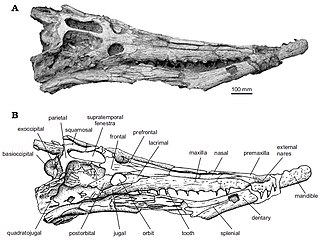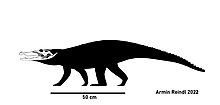
Mekosuchus is a genus of extinct Australasian mekosuchine crocodilian. Species of Mekosuchus were generally small-sized, terrestrial animals with short, blunt-snouted heads and strong limbs. Four species are currently recognized, M. inexpectatus, M. whitehunterensis, M. sanderi and M. kalpokasi, all known primarily from fragmentary remains.

Purussaurus is an extinct genus of giant caiman that lived in South America during the Miocene epoch, from the Friasian to the Huayquerian in the SALMA classification. It is known from skull material found in the Brazilian and Peruvian Amazon, Colombian Villavieja Formation, Panamanian Culebra Formation, Urumaco and Socorro Formations of northern Venezuela.

Paludirex is an extinct genus of mekosuchine crocodylian from the Pliocene and Pleistocene of Australia. A large and robust semi-aquatic ambush hunter capable of attaining lengths of up to 5 m (16 ft), it was likely the top predator of Australia's waterways prior to the appearance of modern saltwater crocodiles. Two species are known, the smaller Paludirex gracilis and the larger Paludirex vincenti. A third as of yet unnamed species may have also existed.

Kambara is an extinct genus of mekosuchine crocodylian that lived during the Eocene epoch in Australia. It is generally thought to have been a semi-aquatic generalist, living a lifestyle similar to many of today's crocodiles. Four species are currently recognised, the sympatric Kambara murgonensis and Kambara implexidens from sediments near Murgon, the poorly preserved Kambara molnari from the Rundle Formation and the youngest of the four, Kambara taraina, also from the Rundle Formation. Kambara were medium-sized crocodilians, with mature specimens generally reaching lengths from 3–4 m (9.8–13.1 ft).

Ceratosuchus is an extinct genus of alligatorine crocodylian from latest Paleocene rocks of Colorado's Piceance Basin and earliest Eocene rocks of Wyoming's Bighorn Basin in North America, a slice of time known as the Clarkforkian North American Land Mammal Age. Like its modern relatives, Ceratosuchus was a swamp-dwelling predator. It is named for the pair of flattened, triangular bony plates that extend from the back of its head.

Dyrosauridae is a family of extinct neosuchian crocodyliforms that lived from the Campanian to the Eocene. Dyrosaurid fossils are globally distributed, having been found in Africa, Asia, Europe, North America and South America. Over a dozen species are currently known, varying greatly in overall size and cranial shape. A majority were aquatic, some terrestrial and others fully marine, with species inhabiting both freshwater and marine environments. Ocean-dwelling dyrosaurids were among the few marine reptiles to survive the Cretaceous–Paleogene extinction event.

Iberosuchus is a genus of extinct sebecosuchian mesoeucrocodylian found in Western Europe from the Eocene. Remains from Portugal was described in 1975 by Antunes as a sebecosuchian crocodilian. This genus has one species: I. macrodon. Iberosuchus was a carnivore, unlike the crocodilians today, they are not aquatic and are instead terrestrial.

Mourasuchus is an extinct genus of giant, aberrant caiman from the Miocene of South America. Its skull has been described as duck-like, being broad, flat, and very elongate, superficially resembling Stomatosuchus from the Late Cretaceous.

Harpacochampsa is a poorly known Early Miocene crocodilian from the Bullock Creek lagerstätte of the Northern Territory, Australia. The current specimen consists of a partial skull and fragments of a long, slender snout reminiscent of that of a false gharial, demonstrating that it was a piscivore in life.

Langstonia is an extinct genus of notosuchian crocodylomorph of the family Sebecidae. It lived in the middle Miocene, in the "Monkey Beds" of the Colombian Villavieja Formation. Langstonia was named in 2007 by Alfredo Paolillo and Omar Linares for fossils originally described by Langston in 1965 as Sebecus huilensis. Thus, the type species is L. huilensis.

Asiatosuchus is an extinct genus of crocodyloid crocodilians that lived in Eurasia during the Paleogene. Many Paleogene crocodilians from Europe and Asia have been attributed to Asiatosuchus since the genus was named in 1940. These species have a generalized crocodilian morphology typified by flat, triangular skulls. The feature that traditionally united these species under the genus Asiatosuchus is a broad connection or symphysis between the two halves of the lower jaw. Recent studies of the evolutionary relationships of early crocodilians along with closer examinations of the morphology of fossil specimens suggest that only the first named species of Asiatosuchus, A. grangeri from the Eocene of Mongolia, belongs in the genus. Most species are now regarded as nomina dubia or "dubious names", meaning that their type specimens lack the unique anatomical features necessary to justify their classification as distinct species. Other species such as "A." germanicus and "A." depressifrons are still considered valid species, but they do not form an evolutionary grouping with A. grangeri that would warrant them being placed together in the genus Asiatosuchus.

Bergisuchus is an extinct genus of small sebecosuchian mesoeucrocodylian known primarily from the Eocene Messel Pit in Germany. Few fossils of Bergisuchus have been discovered, only a single incomplete snout, a few partial lower jaws and some teeth. Despite being fragmentary, the jaw bones are enough to indicate that Bergisuchus had a short, deep, narrow snout and serrated teeth, quite unlike the broad flat snouts of modern crocodylians.

Euthecodon is an extinct genus of long-snouted crocodile. It was common throughout much of Africa during the Neogene, with fossils being especially common in Kenya, Ethiopia, and Libya. Although superficially resembling that of gharials, the long snout was a trait developed independently from that of other crocodilians and suggests a diet of primarily fish. Euthecodon coexisted with a wide range of other crocodiles in the areas it inhabited before eventually going extinct during the Pleistocene.

Sebecus is an extinct genus of sebecid crocodylomorph from Eocene of South America. Like other sebecosuchians, it was entirely terrestrial and carnivorous. The genus is currently represented by two species, the type S. icaeorhinus and S. ayrampu. Several other species have been referred to Sebecus, but were later reclassified as their own genera.

Aegisuchus is an extinct monospecific genus of giant, flat-headed crocodyliform within the family Aegyptosuchidae. It was found in the Kem Kem Formation of southeast Morocco, which dates back to the Cenomanian age of the Late Cretaceous epoch. The type species Aegisuchus witmeri was named in 2012 by paleontologists Casey Holliday and Nicholas Gardner, who nicknamed it "Shieldcroc" for the shield-like shape of its skull. A. witmeri is known from a single partial skull including the braincase and skull roof.

Planocraniidae is an extinct family of eusuchian crocodyliforms known from the Paleogene of Asia, Europe and North America. The family was coined by Li in 1976, and contains three genera, Boverisuchus, Duerosuchus and Planocrania. Planocraniids were highly specialized crocodyliforms that were adapted to living on land. They had extensive body armor, long legs, and blunt claws resembling hooves, and are sometimes informally called "hoofed crocodiles".

Astorgosuchus is an extinct monospecific genus of crocodilian, closely related to true crocodiles, that lived in Pakistan during the late Oligocene period. This crocodile may have reached lengths of up to 8 m (26 ft) and is known to have preyed on many of the large mammals found in its environment. Bite marks of a large crocodile have been found on the bones of juvenile Paraceratherium, however if these were left by Astorgosuchus cannot be said with certainty. The genus contains a single species, Astorgosuchus bugtiensis, which was originally named as a species of Crocodylus in 1908 and was moved to its own genus in 2019.

Ultrastenos is an extinct genus of Australian mekosuchine crocodilian first described in 2016. The type species Ultrastenos willisi was discovered at Riversleigh in northwestern Queensland, Australia, and lived during the Late Oligocene era. Following its discovery, it was speculated that Ultrastenos was a slender-snouted animal similar to modern gharials or freshwater crocodiles and that it may have inhabited forest pools and fed on small vertebrates like frogs and lizards. This is based on the peculiar shape of its mandible, which is wide towards the base of the head but constricts rapidly, leading into a narrow and gracile rostrum. Assuming that the holotype skull belonged to an adult individual, Ultrastenos may have been a rather small animal, approximately the size of a modern freshwater crocodile. However, Ultrastenos is only known from very fragmentary remains and thus among the most enigmatic mekosuchines. In a 2023 study multiple authors argue that the fragmentary nature of the animal means that further studies are required to truly test the hypothesis proposed in its original description, especially following the discovery of what is thought to have been a close relative.
Qianshanosuchus is a genus of basal crocodyloid from the Paleocene of the Qianshan Basin, China. The fossil material, which includes an incomplete skull and parts of the lower jaw, show various features usually associated with juvenile crocodiles alongside various unique traits that were used to erect a new genus. It is the first and only basal crocodyloid currently known from the Paleocene of China, which had previously only yielded alligatoroids and planocraniids. Its presence in this part of the world and its basal position to species of the genus Asiatosuchus supports the idea that crocodyloids dispersed from Asia into Europe. Qianshanosuchus only includes a single species, Qianshanosuchus youngi.

Dentaneosuchus is a genus of large bodied sebecid crocodylomorph from the Middle Eocene of Issel and Réalmont (France). Originally described as Atacisaurus crassiproratus, the discovery of additional remains led to it being placed in a separate genus in 2023. It was tentatively recovered as the basalmost member of the family Sebecidae. Because of this Dentaneosuchus could play an important part in deciphering the origins and dispersal of European sebecids, as their presence on the continent, far away from their primary range in South America, is still not entirely resolved. It reached a similar size to the enormous Barinasuchus, making it not only one of the biggest sebecids but also the biggest terrestrial carnivore of Cenozoic Europe. Dentaneosuchus would have been an apex predator of its environment, capable of taking large prey such as Lophiodon. However, for as of yet unknown reasons crocodylomorphs would lose their spot as top predator in this part of the world by the end of the Eocene, with Dentaneosuchus representing one of the last members of its group in Europe.






















